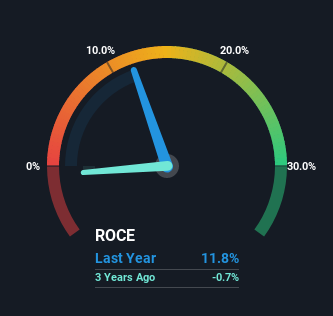Some Investors May Be Worried About Shakti Pumps (India)'s (NSE:SHAKTIPUMP) Returns On Capital

To find a multi-bagger stock, what are the underlying trends we should look for in a business? Amongst other things, we'll want to see two things; firstly, a growing return on capital employed (ROCE) and secondly, an expansion in the company's amount of capital employed. If you see this, it typically means it's a company with a great business model and plenty of profitable reinvestment opportunities. However, after briefly looking over the numbers, we don't think Shakti Pumps (India) (NSE:SHAKTIPUMP) has the makings of a multi-bagger going forward, but let's have a look at why that may be.
What Is Return On Capital Employed (ROCE)?
Just to clarify if you're unsure, ROCE is a metric for evaluating how much pre-tax income (in percentage terms) a company earns on the capital invested in its business. The formula for this calculation on Shakti Pumps (India) is:
Return on Capital Employed = Earnings Before Interest and Tax (EBIT) ÷ (Total Assets - Current Liabilities)
0.12 = ₹514m ÷ (₹7.3b - ₹2.9b) (Based on the trailing twelve months to March 2023).
Thus, Shakti Pumps (India) has an ROCE of 12%. In isolation, that's a pretty standard return but against the Machinery industry average of 16%, it's not as good.
See our latest analysis for Shakti Pumps (India)

Historical performance is a great place to start when researching a stock so above you can see the gauge for Shakti Pumps (India)'s ROCE against it's prior returns. If you're interested in investigating Shakti Pumps (India)'s past further, check out this free graph of past earnings, revenue and cash flow.
So How Is Shakti Pumps (India)'s ROCE Trending?
On the surface, the trend of ROCE at Shakti Pumps (India) doesn't inspire confidence. Over the last five years, returns on capital have decreased to 12% from 23% five years ago. And considering revenue has dropped while employing more capital, we'd be cautious. If this were to continue, you might be looking at a company that is trying to reinvest for growth but is actually losing market share since sales haven't increased.
Another thing to note, Shakti Pumps (India) has a high ratio of current liabilities to total assets of 40%. This can bring about some risks because the company is basically operating with a rather large reliance on its suppliers or other sorts of short-term creditors. Ideally we'd like to see this reduce as that would mean fewer obligations bearing risks.
What We Can Learn From Shakti Pumps (India)'s ROCE
In summary, we're somewhat concerned by Shakti Pumps (India)'s diminishing returns on increasing amounts of capital. Long term shareholders who've owned the stock over the last five years have experienced a 12% depreciation in their investment, so it appears the market might not like these trends either. That being the case, unless the underlying trends revert to a more positive trajectory, we'd consider looking elsewhere.
One more thing to note, we've identified 2 warning signs with Shakti Pumps (India) and understanding these should be part of your investment process.
If you want to search for solid companies with great earnings, check out this free list of companies with good balance sheets and impressive returns on equity.
New: Manage All Your Stock Portfolios in One Place
We've created the ultimate portfolio companion for stock investors, and it's free.
• Connect an unlimited number of Portfolios and see your total in one currency
• Be alerted to new Warning Signs or Risks via email or mobile
• Track the Fair Value of your stocks
Have feedback on this article? Concerned about the content? Get in touch with us directly. Alternatively, email editorial-team (at) simplywallst.com.
This article by Simply Wall St is general in nature. We provide commentary based on historical data and analyst forecasts only using an unbiased methodology and our articles are not intended to be financial advice. It does not constitute a recommendation to buy or sell any stock, and does not take account of your objectives, or your financial situation. We aim to bring you long-term focused analysis driven by fundamental data. Note that our analysis may not factor in the latest price-sensitive company announcements or qualitative material. Simply Wall St has no position in any stocks mentioned.
About NSEI:SHAKTIPUMP
Shakti Pumps (India)
Engages in the manufacture, trade, and sale of pumps, motors, and their spare parts under the Shakti brand name in India and internationally.
Outstanding track record with flawless balance sheet.
Similar Companies
Market Insights
Community Narratives



